A Study of the Design Services Sector on the Island of Ireland
Executive Summary
International evidence supports the observation that there is a close correlation between the use of design and the success of individual businesses as well as the competitiveness of entire countries.
Essentially, this report shows that the use of design by businesses across the island is an under utilized source of competitive advantage.
This does not mean that the Design Services sector is not successful. On the contrary, within the sector’s own definition of success, things are looking good. Optimism is high, growth prospects look good and the sector is populated by highly skilled, experienced practitioners. The problem comes when one considers the needs of the wider economy and the ability of the Design Services sector to fulfil those needs.
The starting point is that the sector is quite small. Not only has it not grown much in the last 10 years, it is also proportionately about one third the size of the sector in Great Britain based either on proportion of total workforce or proportion of Gross Value Added (GVA). This reflects primarily on demand for design services but is also influenced by the desire for growth amongst individual businesses and the nature of what is a relatively isolated, “closed” community of practitioners and clients. Strategies that can encourage growth are important if the sector is to scale up effectively.
Of equal concern is that the sector is not contributing to the economy at the level where it could add most value. The majority of business is confined to activity at the tail-end of the product or service development process such as styling or graphic design. This is not a problem in itself; it is an area where the island can consider itself a world leader although low-cost competitors are starting to enter the market. The problem is that there is limited business activity supporting early stage product development, co-creation or open innovation; these are areas where overseas competition is limited and where the sector can add greatest value to its clients particularly within the service industry. This can best be addressed through education, not only of clients to demand higher value services, but also through continuous professional development within the sector itself.
Amongst the constraints to the sector, the existence of the border appears to limit the opportunities that could be generated by fluent exchange of business between Northern Ireland and Ireland. Not only does this limit growth, it also reduces the scope for generating innovative
services that might arise in a more competitive environment. This is best addressed through transparent access to information about business opportunities both North and South.
The report contains four recommendations addressing the issues of promoting the value of design and the growth and skills requirements of the Design Services sector.
These include:
1. Develop an all-island campaign which promotes the importance of design and the intrinsic value it adds to business.
2. Assist the Design Services sector to expand into new markets and activities across the island and further afield.
3. Support business training amongst design practitioners at both undergraduate level and through continuous professional development.
4. Develop an all-island business programme to facilitate knowledge transfer between the Design Services sector and the end-users of design.
 Click here to download the full report: A Study of the Design Services Sector on the Island of Ireland
Click here to download the full report: A Study of the Design Services Sector on the Island of Ireland
